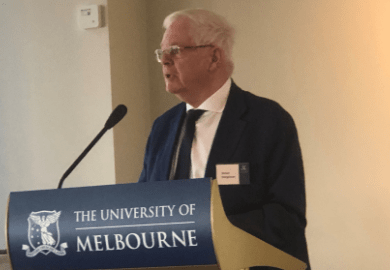Australian universities’ international education income has bounced back from Covid, but soaring costs and flagging domestic demand have left them financially weaker than before the pandemic – ahead of visa policy changes and enrolment caps that could cost them billions of dollars.
A Times Higher Education analysis of publicly funded universities’ financial accounts has found that the sector reaped more than A$10.7 billion (£5.5 billion) from overseas students’ fees last year, up from the previous peak of A$10.6 billion in 2019. This helped push the sector’s overall revenue to a record A$40.8 billion in 2023, almost A$3.3 billion more than in 2019.
But costs rose by A$5.7 billion over the same period, driven primarily by an inflationary surge that added A$2.9 billion to employee expenses and another A$1.6 billion to sundry costs, notwithstanding austerity measures implemented during the pandemic.
This left 24 of the 38 institutions in deficit by the end of last year, with the sector producing an overall surplus of just 0.6 per cent.
Gwilym Croucher, deputy director of the University of Melbourne’s Centre for the Study of Higher Education, said single-year deficits were not necessarily of great concern because they often reflected factors such as fluctuations in universities’ investment portfolios. But “structural” issues in revenue and cost bases were a different matter.
Dr Croucher said some universities were struggling to contain salary bills fuelled by inflation and possibly the costs of “decasualising” the workforce and hiring replacements for staff lost during the pandemic. For other institutions, domestic demand for degrees remained “soft”, partly because of persistently low unemployment.
He said only some universities had benefited from the overall recovery of overseas student income. “Even prior to Covid, there was a real bifurcation in the share of international revenue. It’s hard to see that the financial fortunes of the sector are going to eclipse a pre-pandemic state any time soon.”
Dr Croucher’s research has found that international education earnings remained strong during the pandemic at universities with large overseas cohorts, while often falling dramatically at the remaining two-thirds or so of the sector.
Last year’s annual reports tell a similar story. The 14 universities that earned over A$200 million each from international education in 2019 posted an average surplus of A$35 million last year, increasing their revenue from both overseas enrolments and the Higher Education Loan Programme (Help), which covers domestic students’ fees. The remaining 24 institutions earned less from both sources in 2023 than in 2019 and posted an average deficit of A$11 million last year – often the second successive deficit.
Australian National University higher education expert Andrew Norton said universities with strong international student earnings were “doing extremely well. Others are doing poorly, probably worse than they did last year, yet they’ve still got the same cost pressures…a case of the rich getting richer and the poor getting poorer.”
Professor Norton said 2024 Department of Education funding determinations showed that domestic fee revenue at nine institutions, most of which had big international programmes, had increased by around double the indexation rate of 7.8 per cent. Meanwhile, domestic student contributions at another 10 universities, mostly with small international programmes, had fallen short of indexation.
These same institutions had been so “damaged” by visa policy changes that international enrolment caps would make little difference because they “won’t be able to fill the places anyway”. Meanwhile, they faced escalating compliance costs from the proposed tertiary education commission.
Professor Norton said job losses were inevitable, with administrators forced to assume “worst-case scenarios” to avoid “serious” financial trouble.
“I don’t think there’s been a grimmer outlook,” Professor Norton said. “During Covid, there were strong domestic numbers pretty much across the board, and there was government compensation, which is not going to happen this time. It is looking extremely bad. I think this is the worst policy environment we’ve ever seen.”
Register to continue
Why register?
- Registration is free and only takes a moment
- Once registered, you can read 3 articles a month
- Sign up for our newsletter
Subscribe
Or subscribe for unlimited access to:
- Unlimited access to news, views, insights & reviews
- Digital editions
- Digital access to THE’s university and college rankings analysis
Already registered or a current subscriber?










